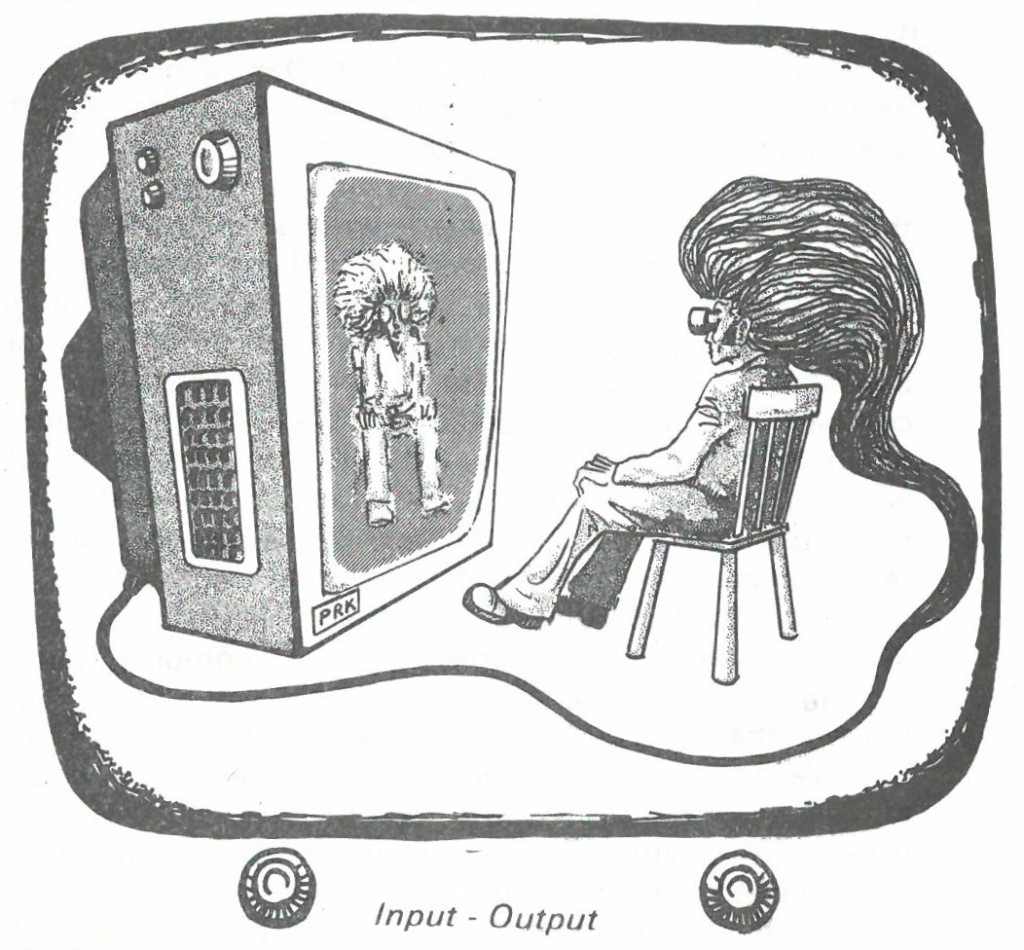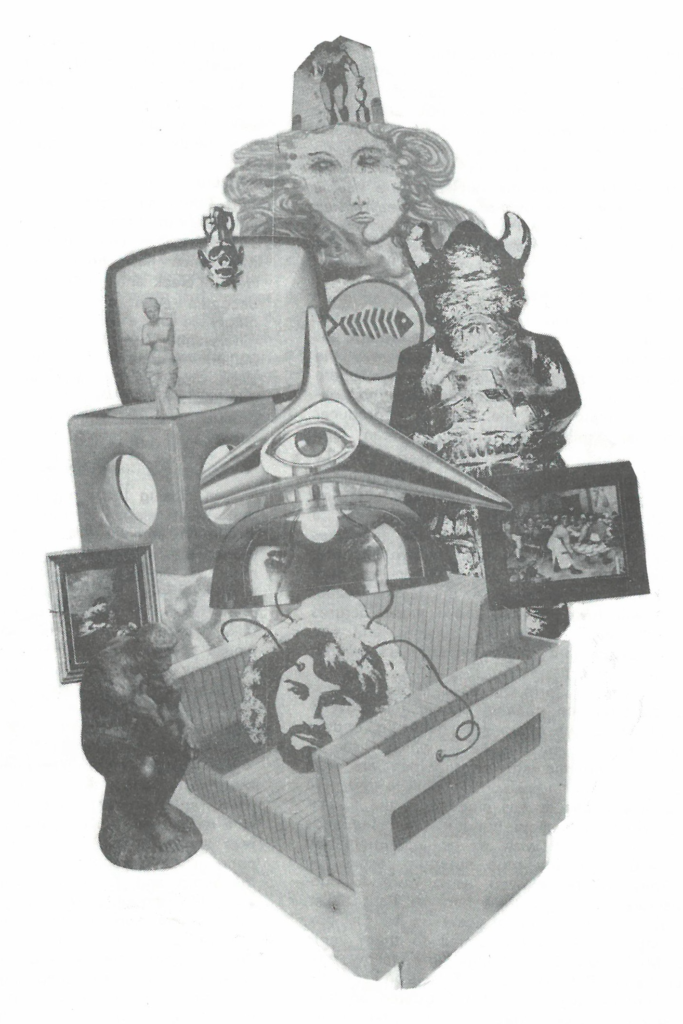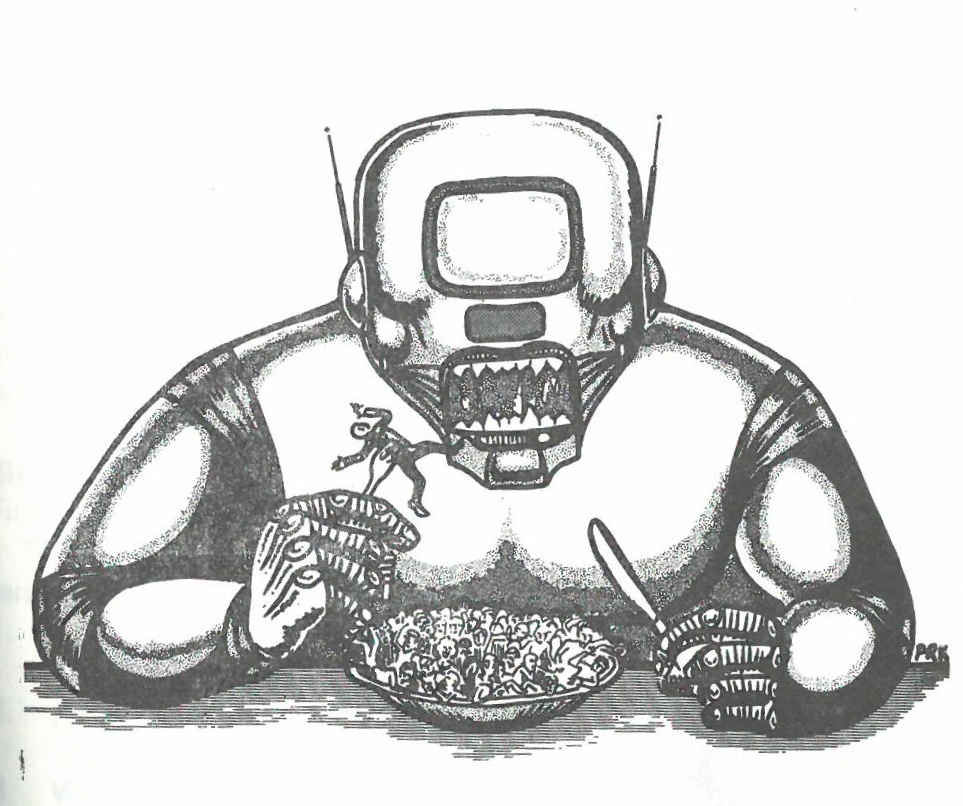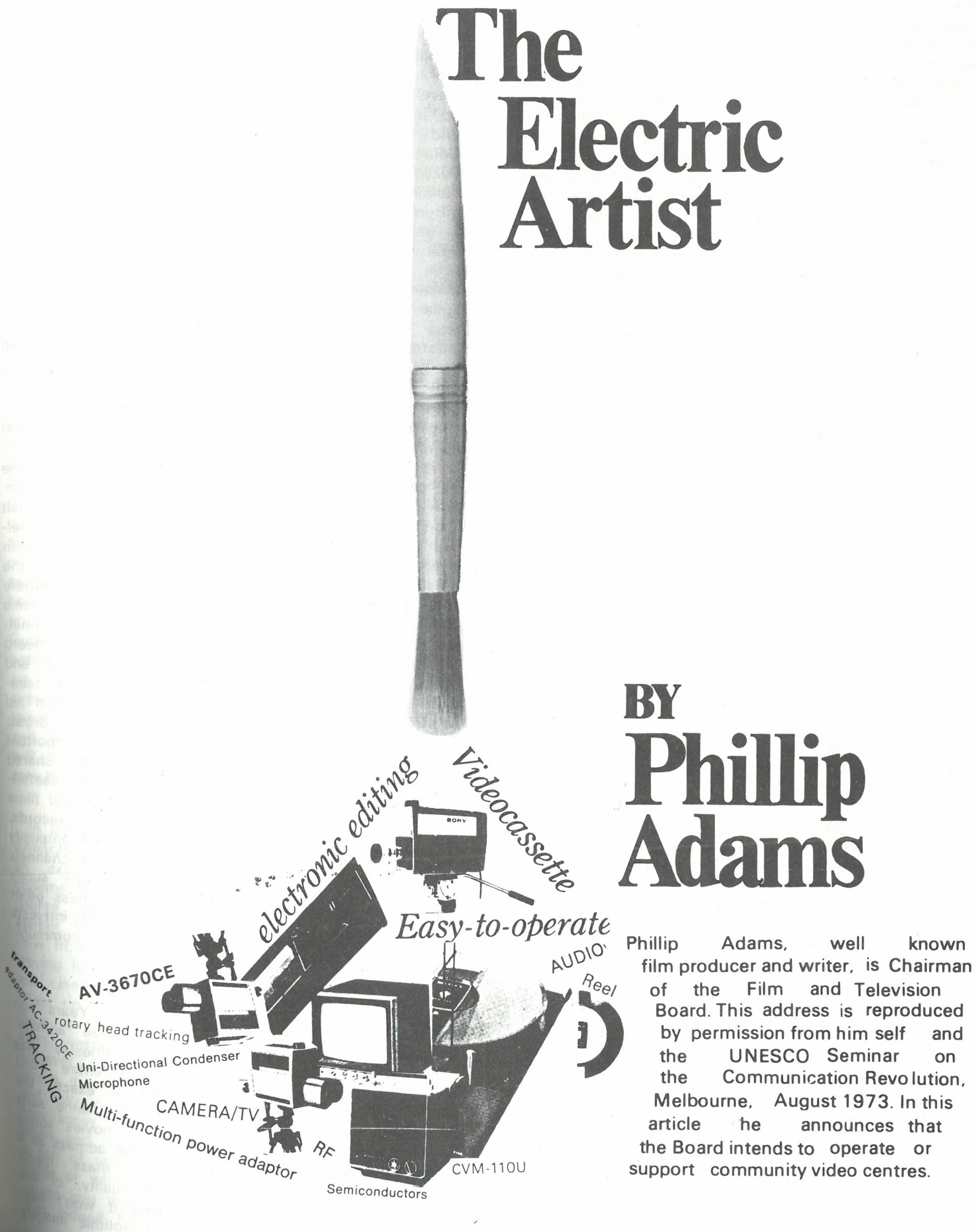I am sure other speakers will have discussed the implications of the wired city, the atomic powered satellites, of the sophisticated cable and fibroptic systems that are fast approaching along with the plethora of video cassettes, cartridges, discs etc. What are the implications of all these clever tricks to the artist?
In the past technology has served the interests of the monopolies by giving them media that they can own, control and manipulate. In contrast the new technologies will serve the concept of diversity, and multiplicity of input – you see it in the way the Xerox machine and cheaper forms of printing have allowed underground publishers and newspapers to get under way in a society where the major dailies and the big magazines tend to face escalating difficulties. You see it in the way the new technologies of 16 mm film and low cost video have allowed an onrush of participatory activity with more and more young people making films or programmes within community groups or co-operatives, while at the same time less and less people are working actively in the professional film industry. I can remember Huxley pointing out that in the 19th century a man could print and publish a book that would pay its way if it sold about 500 copies and this situation encouraged a certain diversity of viewpoint and even of that precious commodity eccentricity. But then we had the modern phenomenon of modern publishing where a book needed to sell a million copies and so content became more generalized, less idiosyncratic, more readily acceptable to a greater number. And the same situation happened in all forms of mass opinion, and cinema, television and the rest. Now the reverse is becoming true and it will soon be economically possible for the individual film maker or writer or what have you to speak to his own community, or at least to those people he identifies as his peers without this degree of compromise. Instead of the obvious ideas, plots, cliches, characterisations, the over-simplified philosophies and more often than not the direct appeal to the lowest common denominator all of which have been characteristic of the old media, the new media will in Chairman Mao’s terms “permit a thousand schools of thought to contend and a hundred flowers to bloom”. Instead of the vicious circle where mass produced mediocrity that fills our media has a soporific effect on its audience (see Ray Newell’s research for the A.B.C. which was published recently), the richness and diversity of human character may escape the subjugations of statistics and throw down some sort of challenge to banality.
Attacking the Monoliths
Now in sociological terms this attack on monolithic banality is I suppose an echo of the way all the monoliths are being challenged – the hardline Communist Party, the Catholic Church, the Pentagon, the Presidency, the multi-national corporations and all the other big, impersonal and largely authoritarian structures that have dominated our lives, they are all subject to escalating attack.
However, a corollary of this liberation movement is the creation of ever more diverse and explicit minorities, so that we face a new danger, fragmentation and inter-group tension, and I tend to disagree with that aspect of a previous speaker. In the past we have had too few voices, in the future we may well have too many. In effect the new technologies will pull mankind in two different directions. On the one hand instantaneous connection of us all via satellite and so forth all tend to blur and ultimately obliterate national differences; already international travellers are using that other mass medium, the jumbo jet, are finding cities resembling each other more and more, the same sort of hotels, the same Coca Cola and Diners’ Club signs, Colonel Sanders outlets in Tokyo, Mr. Wimpey in Paris, the same high-rise buildings and freeways, the same film and television programmes. And in the years ahead there will be a greater tendency for travel, for immigration, for inter-marriage, for the blendings of cultures, and even of language. In the long-term I would expect a sort of international pidgin to develop along the lines predicted by McLuhan, which will certainly lead to reduced international tensions through greater understanding. On the other hand it will be at the cost of richness and diversity, or at least that richness and diversity which is based on geographic or economic circumstances. Counterbalancing this development technology will lead to that new diversity of sub-cultural groups who will be linked by the new electronic media and I suppose by common interest instead of geographic location. You can observe the pattern already, if you visit a pad in Carlton or Sydney or San Francisco or Chelsea or even in Prague – anywhere frequented by teenagers or those in their early twenties, the decor, the music, the clothing will be identical. Everywhere I’ve travelled I’ve seen the same Jimi Hendrix, Janis Joplin posters, heard the same Beatles records, smelled the same smells of incense and marihuana, heard the same sorts of discussions about Vietnam and ecology. In other words the counter-culture teenager in Czechoslovakia isn’t much different from his counterpart in London, France or King’s Cross; national differences seem remarkably unimportant in the light of international identification and shared attributes. Yet these kids are not linked by satellite but by magazines like Rolling Stone and films like Easy Rider and Woodstock, and L.P. records; and the similarity of these groups must intensify as they get access to their own television channels linking them around the globe and that’s surely what will happen. And there will be countless other minorities, all linked together by common interests and by electronic warp and weft, able to communicate instantly across the city or the world.
No admass after all
Now it’s an interesting development. Years ago Priestley wrote about something he called ‘admass’, a phenomenon he deeply feared; Priestley was convinced that within his lifetime the entire world would be brainwashed into looking at exactly the same sort of programmes, wearing the same sorts of clothes, going to the same sorts of movies, voting for the same identikit politician; he saw admass as a conspiracy between marketing and mass media as robbing the world of its individuality; well it won’t happen, because already we see the monolithic imagery of advertising disintegrating as it attempts rather clumsily to communicate with a host of sub-cultures. Instead of just one voice, advertising speaks in hundreds as it tries to identify with everyone from the ‘elite’ to the alternative societies – so we’ve been spared one dreadful fate, that of utter conformity.

But the price of sub-cultural diversity, the price of a world made up of minority groups may be a new sort of ignorance, an intolerance. I’ve said that it will mean the end of one country hating another; it may well be the beginning of one group hating another or the intensification of this problem. We can already see the conflict in our community generated by the generation gap, the tensions between for example migrant groups and the middle class and the skinheads and other teenage groups; already there is a tendency for people to seal themselves off in their own little world, with their own vernacular, their own little ghetto, becoming increasingly insensitive about the rights of others. Well, imagine society with perhaps five or six hundred such groups living a life of their own, talking to themselves, buying their own television and films and music provided by fibroptics or some such technical trick, all but oblivious of what goes on around them in a wider sense: you would have a situation then rather like the one we have in New Guinea, the population speaks about 700 different languages, and this leads to a situation where villagers on one side of the mountain can’t speak to villagers on the other side. Their language or dialect is different. And I would defy the average reader of the Bulletin to make much sense out of Digger, or the reader of Digger to make much sense out of Women’s Weekly; thus hatred and hostility build up, tensions can be fanned by ignorance, and you get tribal conflicts and war, in New Guinea or here. Now while the current media situation leaves much to be desired, at least Australians are getting a national and international view, however dim, through their television; at least they know what’s going on outside their own community and their own national borders. I’m not so sure this will be the case by the end of the century, society may be fragmented into all those tribes.
Holograms and Laser Beams
In lighter vein there will be a tendency for the new technologies of hologram and laser beam to produce an extremely expensive amphitheatre concept of cinema where the audience will sit round a 360 degree image – it will be of course considerably larger than life, a western raging which one can view from any angle, or even from within the image, leaving for dead the primitive effects of 3D, cinerama and cinemascope etc. It will have a very shattering effect on the viewer and will therefore tend to produce a renaissance for those God-awful biblical epics, westerns, films with car chases and massacres; however, as the images will not be contained on a screen it will also involve new concepts in aesthetics, and may well preclude the concepts of film that we now know and accept such as editing, superimposition and montage, forcing the producer back into a sort of unfolding spectacle like the recreation of battle and what have you. If it sounds fanciful let me assure you that the technology is well advanced and that indeed Salvador Dali has been using a static version of the system in his recent art shows in New York.
Smellorama
As well as this one could confidently expect a revival of the ill-fated smellorama of Mike Todd Junior; in the 1950’s Todd unveiled in New York a spectacular travelogue complete with the relevant scents and odours. Unfortunately the ventilation system proved ineffective, and the audience were finally subjected to what could only be described as a nasal montage, or an olfactory cacophony; by all accounts it was an extremely unpleasant experience unless one was lucky enough to have flu. Now that the science of artificial smell has been greatly advanced and you find mass magazines containing stunning photographs impregnated with an appropriate and accurate scent, and the same technology is also required of course for the new man-made foods so as to seduce the consumer into eating synthetic protein under the impression that it his usual T-bone; so these techniques will be applied to cinema along with perhaps variations in cinema temperatures – chill for the Antarctic, hot for the desert – or even a certain amount of motion in the seating as can be experienced already in the simulated moon trip at Disneyland.
Now don’t think for a minute that film makers will be able to restrain themselves from these toys because most of them are in fact children. Eisenstein was theorising on 3D long before it was possible, or Roman Polanski is on record as wanting everything the technician can give him, feelies, smellies, touchies; obviously the greater artist will use these things with more restraint or selectivity than a vulgarian but we can expect a technological return to the sort of spectacle that delighted the Romans or indeed the 19th century theatregoer. One of the implications of this is that they are in a sense monopoly systems, far too expensive for any but the major studios or societies to afford, and I see them as one of the few forms of cinema to survive at a time when the home entertainment options will be so much more seductive.
I talked to you earlier about Dali and his holograms; consider the possibility of hundreds of artists moving into video abstractions instead of the more normal canvas and masonite media; consider the impact on writing when writers themselves can become their own directors instead of handing over their precious scripts to the technicians or interpreters. In the past a writer has had to do this because the technology has been overwhelming, too complex for him to handle; in the future electronic technology means that a kid will be able to record and reproduce an image; so today’s novelists may well be tomorrow’s directors, allowing for an intensification of the much vaunted auteur theory.
At the moment the auteur theory is so much nonsense rendered impossible by the complex nature of the co-operative venture that is a feature film; but in the future it will be possible; one man will be able to make a picture with the help of a couple of technicians; furthermore he will be free from the usual constraints that apply in modern cinema, as most people will be looking at the programme at home on a large and possibly a three-dimensional screen; he’ll not have to worry about the film being 90 minutes long; that’s a discipline placed on the film maker by the necessities of the existing market, the lolly boy and the last train; in future a film may be 3 hours, or 5, or 24 hours long; we’ve seen an intimation of this dreadful possibility in No. 96 which is infinite, or the much admired John Hopkins serial – 6 hours I think it was – the study of a family like ‘Talking to a Stranger’.
Happy days for the writers
Let me quote from Frederick Raphael, one of our more talented screen writers (‘Morgan, a suitable case for treatment’ was one of his, and that Schlesinger film ‘Darling’). He writes, “The writer has always been an employee whose work has always been subject to constant change, revision and emasculation, usually by the director and the producer who later say they made the film that’s right, we do before a single foot has been shot. The time cannot be long delayed when technical changes will alter the whole balance of the movies. As these machines become commonplace it will be possible to create films without the ponderous paraphernalia of studio equipment and staff, which so far have made the imagination of film makers subject to the exigencies of budget and the supposed demands of the mass audience. Books need not remain the sole respectable expression of the writer’s imagination, nor can the higher standards continue to be applicable only to those who commit their ideas to the printed word; how long can the book shelf, the easel painting and the record cabinet remain the sole repository of art in the home? Raphael goes on to imagine himself writing a long script where the normal disciplines and in a sense the falsities of convention can be shunned; instead of having to accommodate his plot to commercial breaks he can spend six or seven minutes exploring an intimate and complex relationship, where the reader-viewer will be able to skim through a part he finds dull just as he does with a novel, or rerun the tape when a piece is particularly interesting or demanding or perhaps erotic.
Along with this liberation I’ve envisaged the dumping of a few other conventions, for example, that of the beautiful star. What a distortion that’s been! To have a long succession of beautiful men and women featured in our films, making outcasts of the rest of us who lack this cosmetic perfection and pulchitrude; in all honesty I believe that this sort of enforced or compulsory romanticism has been damaging to society and has given people quite unnecessary difficulties in their relationships, and it is only in recent times that we’ve seen the cosmetic hero being replaced by a wider variety of facial types; whatever else Mick Jagger is, Perry Como he is not; just as Dustin Hoffman is not Clark Gable. Now obviously these smaller scale, cheaper and more personal films – I will call them films for the sake of convenience – will involve a loss of sheen, of professional quality; and I think people have to become used to this shift of values; in a sense they have been getting used to it with television where drama has more and more given way to a sort of naturalistic quasi documentary delivery; its no accident that journalism has become the art form of our time on television with even the novel degenerating or adapting to the concept of faction, that is, the book based on reality or the Norman Mailer or Truman Capote style of narrative in which a factual account is given of a fictional character or form.

I don’t imagine for a minute that these major technological changes will not wreak havoc with existing aesthetic assumptions; look what the credit card’s done to money; you change a painter’s pigment and you change his art: give a man a telescope and you change his vision; take the camera off the tripod and you give cinema a new immediacy and fluidity; give a director a giant screen and you make possible a film like The Space Odyssey; give him a television screen and you force him to stay close to his subject because spectacle and panorama are untenable in terms of that miserable 17 inch porthole.
Younger filmies
The new technologies will certainly allow ever younger people to become functioning artists and I agree with the previous speaker, I believe there is going to be a huge increase in the incidence of practitioners, also not only in their numbers but in their age: and there will be a tendency for people to give up those art forms that require a long apprenticeship – why go to artschool year after year learning to refine a pencil line when you can reproduce with almost the same accuracy using video gear? Already we see the tendency for ever younger kids to become active in film and television production through our Experimental Film Fund and that will continue.
All together in the Morris Dance
Yet at the same time technology will force many people back to the simple crafts to study stoneware, pottery, woodcarving, to writing in isolation, to the most ancient of aesthetic expressions and I confidentially predict a big boom in Morris dancing and cave painting. Not all of this will be provoked by a growing concern about technology; some it will come about merely because people will have such an abundance of leisure time to fill that the whole tempo of life will be quite different. It’s hard to see the mass concerts surviving in the form we know because quadrasonic and deccasonic sound will be so readily available, giving the full aural spectacle of the symphony in one’s own home with or without the appropriate imagery – well, imagery could be figurative – (that’s a hologram of the orchestra itself) or some sort of assembly of images held to be appropriate to the composition or abstract video imagery of the sort we see in light shows or in those gadgets that generate lacunae from electronic impulses.
Either way, people are less and less likely to travel to mass entertainment given the expense and even the danger of so doing; when I last booked into the St. Regius in New York I found that my television set was ready to give me ‘R’ certificate movies from Room Service; instead of going down Manhattan and running the risk of getting mugged you just rang up Room Service and ordered your meal with I think any one of half a dozen current run movies. Either way people are less likely to travel to mass entertainment because it is getting a little bit more difficult and perhaps more dangerous. Also this will lead to a greater reliance in the music area on electronic synthesising given the total control the composer can have; once again he can rid himself of the problems of another man’s interpretation and himself record the definitive performance; down at Bill Armstrong’s studio there are a few gadgets that already replace musicians that he’s not allowed to use because the union won’t let him; but in due course the synthesiser may well replace the musicians in a professional sense. This doesn’t mean of course that conventional music will die out. Like the people who prefer to throw their own pots, or weave their own cloth, or bake their own bread, it will go on as an alternative, perhaps waiting for a pendulum swing.
Media access centres
This year the Film and Television Board and the Department of Urban and Regional Development will be operating media access centres across the country, or opening them rather, places where people can come and record a programme on a political or social problem with the help of a producer and a technician; this little programme can later be show within the community on closed circuit TV to high rise flats or whatever, you can imagine an aboriginal programme made by aborigines in Redfern being shown to the white community, and a programme made by the whites shown to the aborigines and hopefully those made by both shown together. Or a tape could be replayed on a politician’s desk so he could see for example a dangerous school crossing; we will have five of these video centres trying to break down community tensions and turning passive viewers into media practitioners by the end of this year.
Obviously they could form the basis of a new community access television channel should the Government see fit to create one; personally I’d oppose any increased activities by the A.B.C. which I see as one of those monolithic structures which are well worth challenging, and I personally believe that we will have a new public access channel in the forseeable future which will allow hundreds and hundreds of people, who do not wish to be institutionalised within the A.B.C. or any other structure, access to television. They will be allowed, as it were, to publish on television – to get their film, or their ballet, or their play, or their point of view on to the box, an outlet that is now largely denied to them, more power to Mr. Brian Groombridge, the fellow that wrote that beaut Penguin book, Television and the People. Incidentally, when the B.B.C. offered an hour of public access a week, that is giving time to any group who wished to state their case on network television, they were swamped with inquiries, 700 groups came forward within a couple of days, and the first of these programmes was put together by London’s dead-beats, perhaps upset by the sociological impact of Clockwork Orange; they made an appeal to the public for some understanding and compassion, and they made the programme themselves with just a little bit of help from a staff producer: it included criticisms of the police attitude, of the droogs, of the law relating to vagrancy and so on and perhaps a highly coloured example of what community access is about but nonetheless an interesting one. And because of the continued interest in the sociological use of the media I’d also envisage a continued growth in the documentary, as opposed to the stylised or fictional narrative.
What I’ve said is a brief overview of the future and I know it’s both complex and contradictory; that’s what I would expect, complexities and contradictions, tendencies and tangents, innovations and reactions, in short life will go on as it’s tended to go on for quite some time except that people will be given more and more choice; and from my own observations both here and overseas I’d say that while technology has been delivering the goods the human imagination has shown very little activity. A boring idea in black and white is still boring in colour, and it becomes even more boring when its failings are magnified on a giant screen, so I don’t predict any renaissance; anything but; the number of profoundly brilliant people in this world has always been in short supply and I can’t see that changing unless the dreaded genetic scientists are about to start mass producing them with the manipulation of chromosomes.
Talk-back TV
In closing I am reminded of some predictions by that most elegant writer of science fiction, Ray Bradbury: and he foresaw some new forms of television, one of which would take audience involvement in Coronation Street and talk-back radio just a little further by giving the viewer a part in the drama; in other words the actors on the giant screen talk to the viewer who would talk back; Abigail would talk to you and you’d have your big chance … in a way it’s the development of the rehearsal record that musicians can now buy where a trainee violinist can practise with the Berlin Philharmonic or a would-be concert pianist could practise under the baton of Leonard Bernstein.
But even more intriguing was his masterful short story called ‘Veldt’ – it described a new form of home entertainment; one in effect sat in the tele, in a room made up of glass walls and ceiling; the idea was simple enough – I don’t know whether they’ve done it yet, probably not far off, one would sit in the room and a complex wiring system would pick up one’s thoughts and present them in colour and 3D on the surrounding screen, complete with tactile sensation and smell; as the story opens the proud parents are peeping through the door to see what their kids are imagining on this particular day and are delighted to see the walls and ceiling and floors cluttered with scenes from Alice in Wonderland, but as the weeks passed they tended to hear some strange and terrible noises from the room, but when they opened the room the images are all innocent; more Alice in Wonderland or the Three Bears; but the parents are convinced that the room’s having an unhealthy effect on the kids, that some of their imaginings are decidedly unpleasant, and they decide to take the kids away on a holiday in the country.
When they suggest it to the kids they are furious – they don’t want to go, they cry and scream and tantrum, but such is the parents’ sense of dread of something being awfully wrong that they insist; they agree however that the kids can have one more night sitting in the middle of that vast expanse of status symbol; now a few hours later father approaches the room to collect the kids and he hears some terrifying noises, and smells a strange animally earthy smell and he bursts into the room to try and catch the kids at it, their secret imaginings, only to be confronted by a man-eating lion which walks towards him in 3D colour; hearing a scream his wife rushes to investigate; next morning the neighbours call and are unable to find the parents; they find the kids sitting in their video room right in the middle of the Mad Hatter’s tea party looking very innocent and charming, and the kids don’t know where their parents are; they haven’t the foggiest idea; but as the neighbour leaves the room he notices something on the floor and he picks it up and it’s a man’s wallet, chewed by some giant animal. Written perhaps twenty years ago, it’s an interesting parable because it shows that unless we’re very careful our media may well eat us. (laughter … applause)

Questions
Q. Could I ask Mr. Adams how he is managing contact with these groups who are seeking access; who are they, where do they come from, and how are they making contact?
A. Well first of all I read about Challenge for Change, a Canadian programme, and had been interested in it and been in correspondence with them and met some of their missionaries who have tended to pop around at Film festivals; secondly the Film Board got involved in the Nimbin business, where the students wanted to set up their own closed circuit video centre, and we bought on their behalf quite a large amount of pretty ineffective technical equipment which didn’t work all that well at Nimbin, but nonetheless they produced a vast amount of stuff up there which was shown in a sub-cultural way; now that equipment is with the A.U.S. – the Australian Union of Students who are setting up their own access centre in Melbourne; there are other groups all around the country who have done a lot with their own money; there is one in Melbourne called the Learning Exchange I think; a group who have got together and funded themselves and are operating; and we keep getting a lot of enquiries from people from universities and so forth. In the States it’s even more grass roots than that; it’s not so much based on your academics or your film makers, it’s based more on people just in the community, in the ghettoes and so on, and one of the ones I liked very much was this closed circuit operating from a high rise tower in an attempt to stop people from queuing to leap; they’d set up one of these systems in the basement. The compere was the janitor and the performers were the little girls from Room 305 singing ‘On the Good Ship Lollipop’ or what have you, and they would talk about the weather or what was on special at the supermarket. We think there will be a lot of activities like this as soon as stuff becomes available. And Tom Uren’s Ministry – that’s Urban and Regional Development – will be in it with us; we won’t operate it ourselves, we will just make the facilities available and see what happens. We’re getting rushed with enquiries.
Q. Mr. Stokes, Uni. Queensland: I saw a T.V. programme in England that went into this in some detail; I seem to remember they had hand-held video cameras … (“Well the stuff’s terribly simple – it’s got to be simple”) … it had almost instant playback … (“Yes”) … so anyone could go out in the street and talk …
A. Well, a couple of local politicians have been using them for elections – there’s a group in Melbourne that live in a co-operative … Bert Dehling and Sasha Trikojus. They made themselves available to the A.L.P. in a grass roots way in the election; they were running programmes in the City Square that they recorded instantly with immediate playback … I personally think we ought to go for the colour cassette – the colour stuff isn’t much more expensive now. Even the quadruplex machine which is owned by Ampex to world’s professional standard will soon be out of copyright or patent … it will go into mass production. Now that will bring the prices down again … already the helical scan stuff is getting cheap – I’ve got a colour video recorder player at home with a cassette machine which is $800 – stunning quality – so it’s within access now.
Q. (Gentleman): I have read “Challenge for Change” and the John Hopkins Report … and the various experiments which are done in Canada – and I have just set up a project – to get into community dialogue … yesterday we did one in the community with one of the councillors who is standing for election today … some of it was very good … (“highly illegal isn’t it?”) … (laughter) … well, not … you know he was talking to some of the people in his ward, questions and so on … I am interested if you are going to set up these media centres … how much are we going to be in competition?
A. Surely co-operation; surely. It’s not the Board’s policy to run anything. We are setting things up which we then make available to people – we hope by Christmas to open cinemas in each of the capital cities, but we won’t be running them.
Q. Mrs. Joyce Belfrage, Macquarie Uni.: Mr. Adams, may I ask, if we are going to get the sort of folk art bit in film and television and so forth and the alternative you suggest is the horror of the vast Superstar type 3D or 9D or 5AD biblical epic, where do you expect to place the graduates of the Film and Television School?
A. Well, in America there are 200,000 kids who are coming out of courses in film schools of one sort or another as you know – very few of those will ever get into the industry, the proper Hollywood or the New York industry; most of them are recycled back into education and get involved in these sorts of programmes – I’m not saying it’s entirely a good thing that’s going to happen; it’s a different thing and I think it will happen; whether it will have a good effect finally or a destructive effect, I’m not sure.
Q. (continuing): Yes, well wouldn’t it be true to say that most of the kids who see themselves as going to do work in the Film and Television School see themselves as future professionals in a continuing tradition?
A. Some of them do; many of them don’t. Now for instance one of the students I’m told, one of the best of them there, is a black from Redfern whose attitude is decidedly different. The Experimental Film Fund, when I persuaded Gorton to get it going, it was on the hypothesis that it would be an apprenticeship scheme and the kids would then graduate up the funds to the film factory; not so, I would say more than half the kids are opposed to the concept of commercial cinema, have no interest in becoming professional, and in fact are members of what could be loosely described as the alternative society – wouldn’t accept a $100,000 grant if you gave it to them; so many of them are interested in social change and using films in that way than they are for personal expression – a lack of ego, the old-fashioned projection of personal ego through a feature film – the Fellini proposition – seems to be becoming rarer rather than more common with these kids. You do get group satisfaction – the previous speaker, Dr. Caldwell, made the point that people may get in future satisfaction through group activity – I’m sure he’s right.





